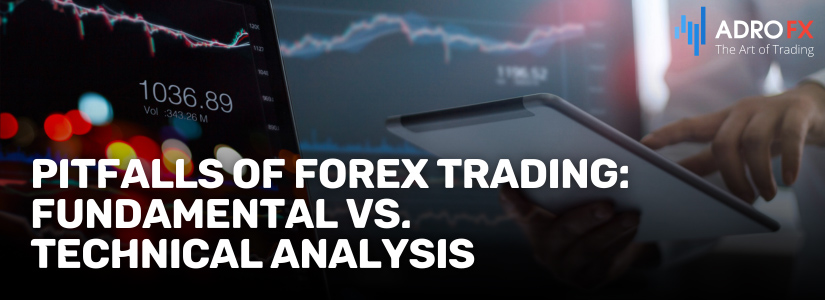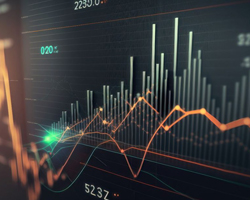Pitfalls of Forex Trading: Fundamental vs. Technical Analysis

Both fundamental and technical analyses are essential strategies in forex trading, each offering distinct perspectives on market trends and trading opportunities. Fundamental analysis looks at economic indicators, geopolitical events, and central bank policies to determine the true value of a currency. Conversely, technical analysis uses historical price data, chart patterns, and indicators to predict future price movements based on past behavior.
While these approaches are valuable for making informed trading decisions, they also come with notable drawbacks that traders must navigate. Understanding these challenges is crucial for those aiming to succeed in the ever-changing forex market. This article examines the pitfalls of both fundamental and technical analyses and suggests ways to mitigate these risks.
Challenges in Fundamental Analysis
Fundamental analysis evaluates a currency's intrinsic value based on economic and political factors, providing a thorough understanding of the underlying drivers of currency valuations. However, this method has its own set of challenges:
- Interpreting Data
Analyzing economic data such as GDP growth rates, inflation figures, employment reports, and central bank decisions can be complex. Often, economic indicators provide conflicting signals, requiring traders to use their judgment to determine their impact on currency markets. - Reaction to News Events
Sudden news events like geopolitical tensions, natural disasters, or major policy announcements can cause immediate market volatility. Traders who rely solely on fundamental analysis may find it difficult to respond quickly to these events, leading to potential losses or missed opportunities. - Timing Issues
Timing is critical in fundamental analysis as market reactions to economic data releases or news events can be quick and significant. Delays in receiving information or using outdated economic forecasts can lead to poor trading decisions.
For instance, consider the release of non-farm payroll (NFP) data in the United States, a significant economic indicator for the USD. If the NFP report differs greatly from market expectations, it can lead to sharp movements in USD-related currency pairs, impacting traders who did not accurately anticipate the outcome.
By understanding these challenges, traders can refine their fundamental analysis techniques, enhance their decision-making processes, and incorporate effective risk management practices to better navigate the forex market.

Technical Analysis: Challenges and Pitfalls
Technical analysis involves examining historical price data, chart patterns, and various technical indicators to predict future price movements. This approach helps traders identify trends, support and resistance levels, and potential entry and exit points based on previous market behavior. However, technical analysis also comes with its own set of challenges:
- Subjectivity
Technical analysis can be highly subjective. Different traders may interpret the same chart patterns or indicators differently, leading to inconsistent trading decisions and outcomes. This subjectivity can undermine the reliability of trading strategies. - Over-Reliance on Indicators
There is a danger in overloading charts with too many indicators or relying excessively on technical signals without considering the broader market context. This can result in "analysis paralysis," where an abundance of information clouds judgment and leads to poor decision-making. - False Signals
Technical analysis is prone to false signals, such as false breakouts or breakdowns. These occur when a price temporarily moves above or below a significant level but then reverses, misleading traders into premature trades or exits.
For example, a trader might identify a head and shoulders pattern on a currency pair's chart, indicating a potential trend reversal. If the trader enters a short position based solely on this pattern without considering other factors like market sentiment or upcoming economic events, they might fall prey to a false breakdown. If market sentiment unexpectedly shifts, the price could reverse against the trader's position, resulting in a loss.
Comparison and Contrast
Fundamental and technical analyses, while distinct, are both essential in forex trading, each with unique challenges and advantages.
Fundamental Analysis
- Approach
Involves interpreting economic data, news events, and geopolitical factors to assess a currency's intrinsic value. - Strengths
Provides insights into long-term trends and economic conditions. - Challenges
Requires timely interpretation of data releases and news events. Traders must navigate the subjectivity in interpreting economic indicators and the impact of unexpected news on market volatility.
Technical Analysis
- Approach
Focuses on historical price data, chart patterns, and technical indicators to forecast future price movements. - Strengths
Identifies trends, support and resistance levels, and specific entry and exit points based on past behavior. - Challenges
Can be subjective, leading to varied interpretations and decisions. Prone to false signals that can mislead traders during volatile market conditions.
In volatile markets, fundamental analysis may struggle to predict sudden shifts caused by unexpected news or geopolitical tensions. Meanwhile, technical analysis may face challenges due to increased market noise and false signals. In stable markets, fundamental analysis can offer clearer insights into long-term trends, while technical analysis excels at identifying precise entry and exit points within defined price ranges.
By integrating both fundamental and technical analyses into their trading strategies, traders can mitigate the risks associated with each approach while leveraging their strengths. Fundamental analysis provides a broader economic context and long-term insights, complemented by technical analysis's ability to pinpoint specific trading opportunities within shorter timeframes. This combined approach allows traders to make more informed decisions and adapt effectively to various market conditions.

Strategies to Mitigate Pitfalls
Navigating the challenges of fundamental and technical analysis requires traders to adopt proactive strategies that enhance decision-making and risk management.
Risk Management
Central to any trading strategy is effective risk management. Traders should use techniques such as setting stop-loss orders to limit potential losses and applying position sizing to manage exposure relative to account size and risk tolerance. By defining risk parameters before entering a trade, traders can mitigate the impact of unexpected market movements.
Diversification
Avoiding over-reliance on any single analytical method or timeframe is crucial. Diversifying analytical approaches - by integrating both fundamental and technical analysis - and using multiple timeframes for analysis can provide a broader perspective. This approach helps traders confirm signals across different methods and timeframes, reducing the risk of making decisions based on isolated or conflicting signals from a single approach.
Continuous Learning
Markets are dynamic, and staying informed about economic developments, geopolitical events, and shifts in market sentiment is essential. Traders should engage in continuous learning by keeping abreast of market news, economic reports, and industry trends. Adapting trading strategies based on new information and evolving market conditions allows traders to make informed decisions and adjust their approaches in response to changing environments.
By incorporating these strategies into their trading routines, traders can mitigate the inherent risks associated with fundamental and technical analysis. Proactively managing risk, diversifying analytical methods, and staying informed empower traders to navigate challenges effectively and improve overall trading outcomes.
Conclusion
Fundamental and technical analyses are indispensable tools for navigating the complexities of forex trading, each offering unique perspectives on market dynamics and trading opportunities. Fundamental analysis delves into economic indicators, geopolitical events, and policy decisions to assess a currency's underlying worth, providing insights into long-term trends and economic conditions. Conversely, technical analysis relies on historical price data, chart patterns, and technical indicators to forecast short-term price movements and pinpoint entry and exit points based on past market behavior.
Despite their utility, both methodologies come with inherent pitfalls that traders must carefully manage. Fundamental analysis demands precise interpretation of economic data and events, with swift reactions necessary to mitigate the impact of unexpected news and market volatility. Meanwhile, technical analysis can be subjective, prone to false signals, and over-reliant on indicators, potentially leading to misguided trading decisions during volatile or noisy market conditions.
Understanding these challenges is crucial for traders aiming to optimize their strategies and achieve consistent success. By integrating fundamental and technical analyses, traders can harness the strengths of each approach while mitigating their respective weaknesses. Fundamental analysis provides a macroeconomic context and strategic insights, while technical analysis offers precise timing and tactical entry points within fluctuating markets.
To navigate these challenges effectively, traders should employ proactive strategies such as robust risk management practices, diversification of analytical methods across different timeframes, and continuous learning to adapt to evolving market conditions. By staying informed and agile, traders can enhance decision-making processes, reduce risks, and ultimately improve their overall trading outcomes in the dynamic forex market.
In conclusion, embracing a balanced approach that integrates fundamental and technical analyses equips traders with a comprehensive toolkit to navigate the complexities of forex trading, capitalize on opportunities, and mitigate risks effectively. By mastering these methodologies and adapting to changing market dynamics, traders can position themselves for success in the competitive world of currency trading.
About AdroFx
Established in 2018, AdroFx is known for its high technology and its ability to deliver high-quality brokerage services in more than 200 countries around the world. AdroFx makes every effort to keep its customers satisfied and to meet all the trading needs of any trader. With the five types of trading accounts, we have all it takes to fit any traders` needs and styles. The company provides access to 115+ trading instruments, including currencies, metals, stocks, and cryptocurrencies, which make it possible to make the most out of trading on the financial markets. Considering all the above, AdroFx is the perfect variant for anyone who doesn't settle for less than the best.










